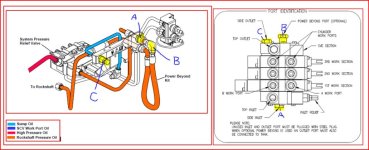I am sorry Andy @ Wayne County Hose, if I did not explain clear enough. My intention was not to make anyone upset, about this. I am just seeking the JD motivation about this design. Trying to learn!! Interesting to hear from J_J, that equipment with this suction filter bypass, are now getting rebuilt.....
I try to use the qoutation system , on my reply so there wont be any misunderstanding about my replies.
Also please read these
"facts" from Wikipedia....
AKKAMAAN, I believe you are waaaay overthinking this. And actually, there are completely sealed systems out there (Like on a Moffett piggyback forklift found frequently on Lowes and Home Depot delivery trucks) which have absolutely zero atmospheric pressure in the hydraulic tank or system. There goes the "no atmospheric pressure= no oil in the pump" theory.

Here is my own quote:
"When a pump "sucks" in the oil, it is technicly the atmospheric pressure that pushes the oil into the empty space that the pump creates on the inlet side when turning.
NO atmospheric pressure= NO oil into the pump."
My statement of course concider the standard VENTED tank setup, we had on the drawing. It also concider perfect vacuum as referens point for pressure.
I am sure you don't mean it is vacuum in that
Moffett tank system, or pressure below atmosheric pressure. Completely sealed systems has been around for a long time. The ones I have come across, have a breather cap that sets up a 1-2 psi over-pressure in the tank, to secure oil "feeding" the pump. Atmospheric pressure PLUS 1-2 psi!
In most systems, initially, yes it is atmospheric pressure pushing oil into the pump. However, once the pump starts going, there is no longer atmospheric pressure pushing oil into the suction line, there is instead a vacuum created by the pump. It is also kinda misleading to state that a suction filter bypass valve opens at ANY psi.
Not misleading at all, if the referens point for pressure is perfect vacuum, zero psi in absolute pressure!
It opens from vacuum. It is sucked open, not pushed open. If you look at a gauge on a suction filter, it is not a pressure gauge, it is a vacuum gauge. The needle rotates counter-clockwise for vacuum, pressure gauges rotate clockwise.
If we, daily in hydraulic life, call it that pump "sucks" the oil in, is not a big deal, we all use that way of discribing it, but when it comes to understanding any pressure science that occurs below atmospheric pressure, we need to use the absolute pressure referens, perfect vacuum is ZERO. everything above is "plus" on the pressure scale.
There is oil under pressure there but it's pressure is caused by gravity more than atmospheric pressure. Just because we make a box and seal it doesn't mean it has 14 psi in it
I never said that, thats your interpretation....
Just wondering, where did you come up with that pumps cavitate at 15 psi? It would be rated at inches of mercury anyway, and I have seen pumps pull way more vacuum than 15" without cavitating.
I never said that either, thats your interpretation....
Inches of mercury is not a common unit in hydraulics...
I do appreciate you sharing your knowledge and I am not being a "wisenheimer" so please don't take it that way. I too have a ton of hydraulic schooling, most of it application specific. Maybe I'm not understanding something in this but I'm referring back to my tech manuals and 25+ years of field experience.
Thanks, Andy
Again...no harm! I probobly sound more like a "wisenheimer" than you did.... (what ever that means, I suppose it is not something good...LOL).
I have been in tougher discussions than this. I have allways backed off when I have been proofed wrong. But never when I can proof I am right. All my students over my 20+ year teaching career, have always walked out of the classroom happy with this scientifcally accepted "theory".
I am sure all of you other guys here at TBN have more experience, training and skills in YOUR part of the hydraulic world than I have!
My hydraulic world have been teaching and training logging equipment to operators and technicians. I have two different engineering degrees, forestry and construction. Hydraulics by self learning and and a lot of 1-3 week classes at JD (former Timberjack) and Komatsu (former Valmet)
Thats why I choose to be here at TBN, trying to learn more about, to me, new applications, but also give back some of my knowledge and experience.
Cheers
Per A, "aw come on"....









